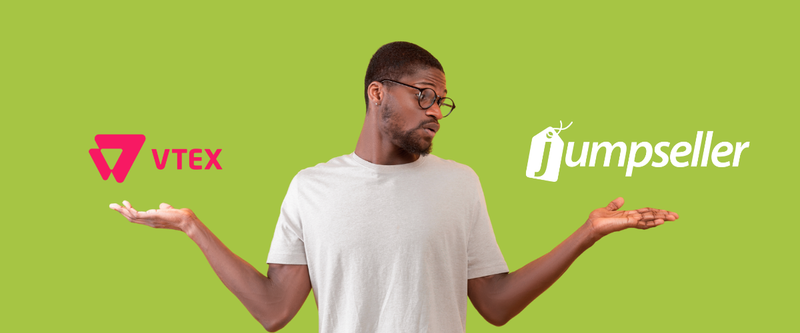Choosing the right eCommerce platform is a strategic decision for agencies managing multiple stores and large enterprise holdings with global ambitions. Jumpseller, with its Advanced and Enterprise plans, and VTEX, a leading solution for corporations, offer distinct approaches to meeting eCommerce needs.
This article compares Jumpseller Advanced, Jumpseller Enterprise, and VTEX across ease of use, customization, costs, and scalability, providing an objective analysis to inform your decision.
Overview of the platforms
Jumpseller Advanced encompasses all of Jumpseller’s core functionalities, designed for businesses that seek simplicity and efficiency. With an intuitive interface, support for multiple languages, currencies, and sales channels, it is ideal for agencies managing growing stores. It offers dynamic pricing rules, distributed inventory management, and a cloud infrastructure optimized for high-demand events.
Jumpseller Enterprise includes all Advanced features, adding strategic alignment with the business through a transparent 0.5% + VAT commission on sales and a dedicated Key Account Manager (KAM). This plan supports advanced customizations on demand, such as integrating new sales channels or bespoke workflows, backed by a 40-member engineering team with master’s degrees in software engineering.
VTEX is an enterprise-grade platform focused on unified commerce, ideal for large companies with complex B2B, B2C, and marketplace needs. Its microservices-based architecture and headless capabilities support intricate operations, though implementation often requires specialized technical teams.
Comparative overview
| Criterion | Jumpseller Advanced | Jumpseller Enterprise | VTEX |
|---|---|---|---|
| Ease of Use | Intuitive interface, adopted by thousands of stores. | Similar to Advanced, with personalised KAM support. | Complex, requires technical expertise. |
| Customization | Editable templates and flexible API. | Advanced customizations on demand. | High customization, more complex and costly. |
| Costs | Fixed, transparent, and affordable plans. | 0.5% + VAT commission, plus fixed plans. | Revenue-sharing model, less predictable. |
| Scalability | Optimized for growing businesses. | Same as Advanced, with tailored global solutions. | Built for complex, global corporations. |
Detailed analysis
1. Ease of use: simplicity vs. Technical complexity
Jumpseller Advanced enables agencies to set up and manage stores in hours, thanks to an intuitive interface adopted by over 8,000 merchants, particularly in demanding markets like Chile. Features like product management, payments, and shipping are accessible without advanced technical knowledge.
Jumpseller Enterprise maintains this simplicity while adding a dedicated KAM who acts as an extension of the client’s team, coordinating customizations and strategic support.
VTEX, while powerful, has a steep learning curve. Its advanced configurations often require technical expertise, delaying implementation for agencies with limited resources.
Conclusion: Jumpseller excels in simplicity, while VTEX requires significant technical investment.
2. Customization: Flexibility for brands and agencies
Jumpseller Advanced offers editable templates and a flexible API, allowing agencies to customize stores without specialized developers.
Jumpseller Enterprise expands this with on-demand customizations supported by a 40-member engineering team. Clients can request integrations like new sales channels or workflow automation.
VTEX provides extensive customization, especially for headless commerce or ERP integrations. However, the ecosystem can impose constraints, and deep customization usually requires developers.
Conclusion: Jumpseller Enterprise matches VTEX in advanced customization, with more accessible implementation.
3. Costs: Transparency vs. revenue-sharing
Jumpseller Advanced offers fixed and transparent pricing, ideal for agencies with defined budgets and no hidden fees.
Jumpseller Enterprise combines fixed pricing with a 0.5% + VAT commission model, aligning platform incentives with business growth.
VTEX uses a revenue-sharing model tied to sales, which can reduce margins. Pricing is not publicly disclosed, and implementation/customization costs can be significant.
Conclusion: Jumpseller offers predictable and affordable costs, while VTEX may be expensive for high-volume operations.
4. Scalability: Global growth and high-demand events
Jumpseller Advanced runs on microservices and a cloud infrastructure optimized for events like Black Friday. It supports multiple currencies, languages, and global compliance.
Jumpseller Enterprise enhances this with solutions for unified commerce and custom expansion paths for global markets.
VTEX is ideal for massive catalogs and complex operations. Its headless model supports advanced integrations but requires technical management.
Conclusion: Both Jumpseller plans are highly scalable and cost-effective. VTEX suits highly complex global enterprises but adds technical overhead.
Conclusion: The strategic choice for your business
Jumpseller Advanced is ideal for agencies and businesses that value simplicity, scalability, and modern eCommerce tools like dynamic pricing and distributed inventory.
Jumpseller Enterprise builds on this foundation with a strategic, growth-aligned pricing model and a dedicated KAM, offering advanced customization and global support.
VTEX is a powerful option for corporations requiring unified commerce and ready to invest in complex, technical implementations. However, its cost and complexity may not suit all agencies or holdings.
Final thought: For agencies or holdings seeking scalable, transparent, and flexible eCommerce solutions, Jumpseller Advanced and Enterprise offer unmatched value and ease of implementation.
Discover how Jumpseller Advanced and Enterprise can empower your business. Create your store today.






